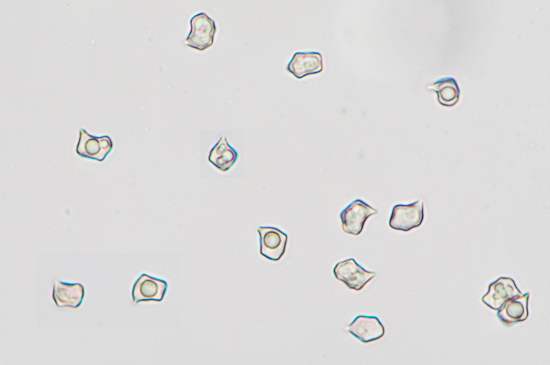Entoloma lucidum (P. D. Orton) M.M. Moser
Phylum: Basidiomycota - Class: Agaricomycetes - Order: Agaricales - Family: Entolomataceae
Distribution - Taxonomic History - Etymology - Identification - Culinary Notes - Reference Sources
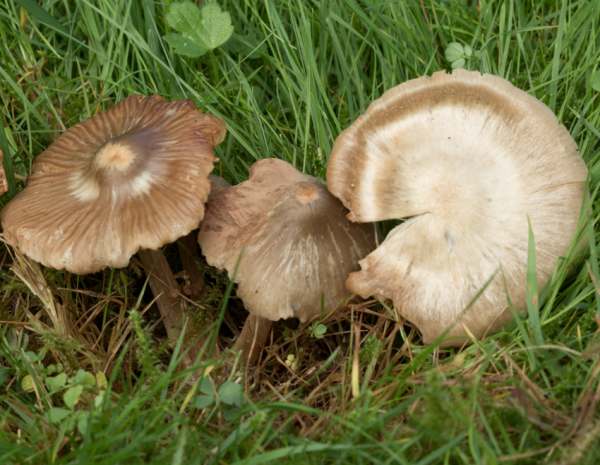
Entoloma mushrooms are commonly referred to as 'pinkgills', and most of them are very difficult to identify with certainty. Entoloma lucidum is no exception and, because it is also quite a rare, find most people interested in fungi never become really familiar with it.
Distribution
This attractive little grassland mushroom is an uncommon find in Britain and Ireland, although it is quite widely distributed. Entoloma lucidum occurs also throughout much of mainland Europe, where it is rarely more than an occasional find, and in parts of North America.
Taxonomic history
When in 1960 British mycologist Peter Darbishire Orton described this species he gave it the scientific (binomial) name Nolanea lucidum. It was Austrian Mycologist Meinhard Michael Moser (1888 - 1977) who, in a 1978 (posthumous, therefore) publication, transferred this species to its present genus, whereupon its currently-accepted scientific name Entoloma lucidum was established.
Synonyms of Entoloma lucidum include Leptonia lucidum P. D. Orton and Nolanea cericea.
Etymology
The generic name Entoloma comes from ancient Greek words entos, meaning inner, and lóma, meaning a fringe or a hem. It is a reference to the inrolled margins of many of the mushrooms in this genus.
The specific epithet lucidum comes from the Latin adjective lucidus and means bright, shining or clear.
Identification guide
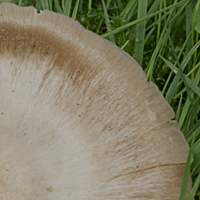 |
Cap1 to 5cm across; initially conical becoming convex; often umbonate; smooth; brown or grey-brown, hygrophanous, paler when dry; the cap margin is translucently striate. |
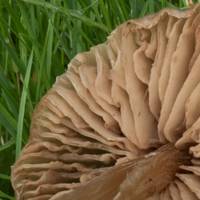 |
GillsModerately spaced, adnate to emarginate or almost free; pinkish-grey to pinkish-brown. Cheilocystidia absent. StemCylindrical, 4 to 8cm long and 1 to 5mm in diameter; grey-brown to yellowish-brown; longitudinally silvery fibrillose; no stem ring. |
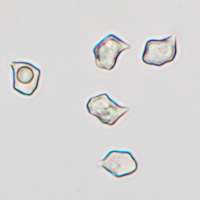 |
SporesHeterodiametrical (ellipsoidal, 5-7-angled in side-view), thin-walled; 8-10.5 x 6.5-9μm. Spore printBrownish pink. |
Odour/taste |
Odour slight, farinaceous (like wet flour) or rancid; taste not distinctive. |
Habitat & Ecological role |
Saprobic in in grassland and in grassy clearings in deciduous woodland. |
Season |
Fruiting summer and autumn in Britain and Ireland. |
Similar species |
There are several similar small brownish Entoloma species that cannot reliably be separated on macroscopic characters alone; key identification features include spore shapes and sizes and the form and dimensions of cystidia on the gill edges, capss and stem. |
Culinary Notes
It is unclear whether this is a toxic toadstool, but as some Entoloma species - for example Entoloma sinuatum - are known to be deadly poisonous it seems sensible to treat Entoloma lucidum as suspect and not to be collected for eating. (Its small size and it scarcity are two more good reasons for not collecting this species other than when necessary for research purposes.)
Reference Sources
Knudsen H., Vesterholt J. (eds) Funga Nordica: agaricoid, boletoid and cyphelloid genera - Nordsvamp, 2008
Dictionary of the Fungi; Paul M. Kirk, Paul F. Cannon, David W. Minter and J. A. Stalpers; CABI, 2008
Taxonomic history and synonym information on these pages is drawn from many sources but in particular from the British Mycological Society's GB Checklist of Fungi.
Acknowledgements
This page includes pictures kindly contributed by David Kelly.
Fascinated by Fungi. Back by popular demand, Pat O'Reilly's best-selling 450-page hardback book is available now. The latest second edition was republished with a sparkling new cover design in September 2022 by Coch-y-Bonddu Books. Full details and copies are available from the publisher's online bookshop...
